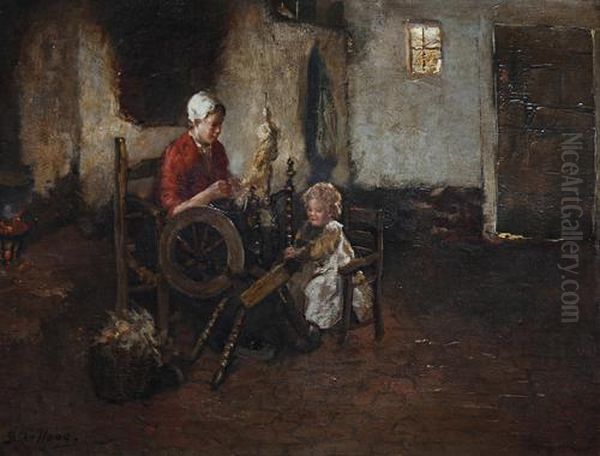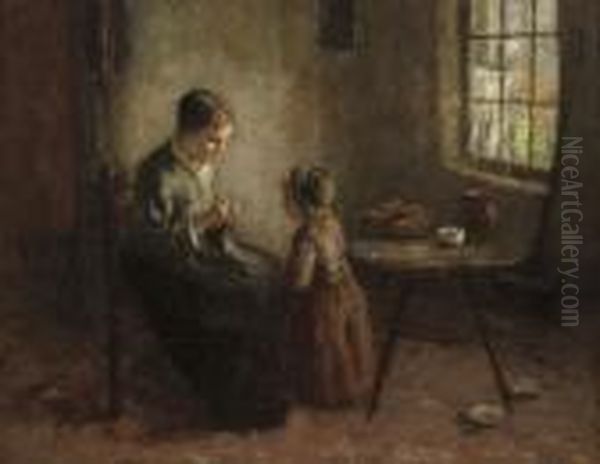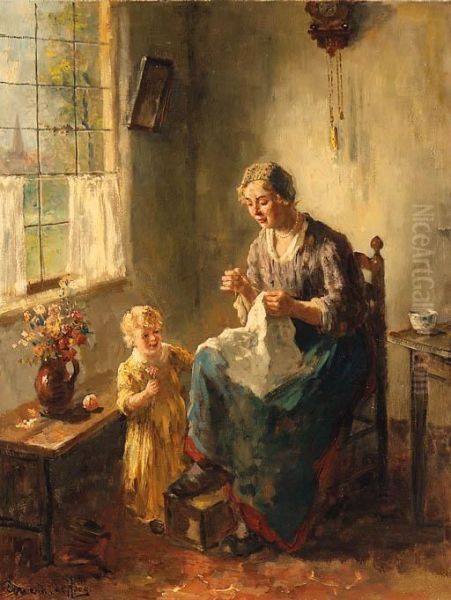Bernard Johann De Hoog stands as a significant figure in Dutch art history, particularly associated with the later phase of the renowned Hague School. Born in Amsterdam in 1866 and passing away in 1943, De Hoog carved a niche for himself by capturing the intimate, often poignant, moments of Dutch domestic and rural life. His journey into the art world was not straightforward, beginning in commerce before his innate talent and passion for painting led him down a different path, ultimately establishing him as a respected artist both within the Netherlands and internationally. His work resonates with a warmth and sincerity, focusing on the simple virtues and quiet dignity of everyday existence.
From Commerce to Canvas: An Unconventional Start
Unlike many artists who demonstrate their calling from a young age, Bernard De Hoog initially pursued a career in business. This practical start in life perhaps imbued his later work with a grounded sense of reality. His artistic inclinations, however, could not be suppressed. While working in a merchant's office, his talent began to surface through sketches and drawings he produced in his spare time. Recognizing the potential in these works, his employer played a crucial role in altering De Hoog's life trajectory.
This supportive merchant encouraged the young De Hoog and facilitated his introduction to a painter who could provide initial guidance. This marked the beginning of his formal artistic journey. Furthering his commitment, De Hoog eventually enrolled in an art academy, dedicating himself to mastering the craft. This transition was not without challenges; some accounts suggest his father initially disapproved of his artistic ambitions, favouring a more conventional career path. However, De Hoog's determination, coupled with external encouragement, prevailed.
Early Influences and Artistic Formation

During his formative years as an artist, De Hoog immersed himself in the study of the Dutch Golden Age masters. He spent considerable time copying the works of celebrated 17th-century painters, a traditional method for honing technical skills and understanding composition, light, and form. Among those he particularly studied were Pieter de Hooch, renowned for his tranquil domestic interiors and masterful handling of light, and Frans Hals, famous for his lively portraits and dynamic brushwork. This engagement with the past provided De Hoog with a strong technical foundation.
While these early exercises involved emulating the style of the Old Masters, De Hoog gradually synthesized these influences into his own distinct artistic voice. He moved away from direct imitation towards developing a style that, while rooted in Dutch tradition, reflected the sensibilities of his own time. His focus shifted towards genre scenes, particularly the depiction of peasant life, cottages, and intimate family moments, which would become the hallmark of his oeuvre.
The Hague School Connection
Bernard De Hoog is most closely associated with the Hague School (Haagse School), a pivotal movement in Dutch art during the latter half of the 19th century. Flourishing roughly between 1860 and 1900, the Hague School artists sought a realistic portrayal of their surroundings, turning away from the idealized scenes of Romanticism. They were inspired by the French Barbizon School but focused intently on the specific landscapes, coastal scenes, and everyday life of the Netherlands. Atmosphere, light, and mood were paramount.
Key figures of the Hague School, whose work and ethos undoubtedly influenced De Hoog, include Jozef Israëls, often considered one of the school's leading figures, known for his sympathetic portrayals of fishermen and rural families. Others like Anton Mauve, celebrated for his landscapes with sheep, Hendrik Willem Mesdag, the master of seascapes, the Maris brothers (Jacob, Matthijs, and Willem), Johannes Bosboom with his church interiors, and landscape painters like Paul Gabriël and Willem Roelofs, collectively shaped the artistic environment in which De Hoog matured.
De Hoog embraced the Hague School's commitment to realism and its focus on humble subjects. He shared their interest in capturing the nuances of light and atmosphere, particularly the soft, diffused light characteristic of the Dutch climate. His work aligns with the school's later phase, which sometimes incorporated slightly brighter palettes and looser brushwork compared to the earlier, more tonal "grey school" period. He became acquainted with contemporaries like Albert Neuhuys and Hendrik Kever (likely Johannes Hendrik Kever), who also specialized in genre interiors, further embedding him within this artistic milieu. Evert Pieters was another contemporary active in similar circles.
Style and Thematic Focus

De Hoog's artistic style is characterized by its warmth, intimacy, and focus on the domestic sphere. He excelled in depicting the interiors of modest Dutch homes, often centering his compositions around mothers and children engaged in quiet activities – sewing, reading, preparing food, or simply sharing a moment of familial connection. These scenes are imbued with a sense of peace, security, and simple contentment, reflecting an idealized yet relatable vision of family life.
His treatment of light is particularly noteworthy. Drawing inspiration from 17th-century masters like Pieter de Hooch and Johannes Vermeer, De Hoog skillfully used light, often streaming through a window, to illuminate his subjects and create a gentle, atmospheric mood. He masterfully rendered textures – the rough weave of cloth, the gleam of polished wood, the softness of skin – adding to the realism and tactile quality of his paintings. While grounded in realism, his brushwork could be relatively loose and expressive, hinting at Impressionistic influences in the application of paint and capture of fleeting moments.
He often employed a rich, warm palette, favouring earthy tones, deep reds, and soft ochres, enhancing the cozy and inviting atmosphere of his interiors. Some sources note his use of thick paint application and strong brushstrokes, possibly layered with glazes to achieve depth and luminosity, techniques that contribute to the visual richness of his work. Children frequently feature as central figures, depicted with tenderness and an understanding of their innocent world, reinforcing the themes of family and domestic harmony.
Representative Works and Subject Matter
While specific titles recur in auction records and collections, one work often cited as representative is Interior Scene of a Mother and Daughter. This title encapsulates the essence of his most frequent subject matter. His paintings typically portray scenes such as 'The Sewing Lesson', 'Feeding Baby', 'A Mother's Care', or 'Playing by the Hearth'. These titles themselves underscore his consistent focus on the nurturing aspects of family life and the quiet rhythms of the household.
The settings are usually simple, rustic interiors – a cottage kitchen, a humble living room – rendered with attention to detail that conveys authenticity without becoming overly cluttered. Elements like spinning wheels, cradles, simple furniture, and hearth fires often appear, grounding the scenes in a specific cultural and social context. The figures within these settings are portrayed with dignity and empathy, elevating the everyday tasks and interactions into moments worthy of artistic contemplation. His ability to capture tender emotions and familial bonds resonated deeply with audiences.
Career, Recognition, and International Appeal

De Hoog achieved considerable success during his lifetime. His artistic journey benefited from opportune support, including, according to some accounts, a subsidy from the Dutch Queen, which would have provided crucial financial assistance and recognition early in his career. He exhibited his work regularly in the Netherlands, including in major centres like Amsterdam, as well as in various provincial and national exhibitions, gradually building his reputation.
His appealing subject matter and skillful execution found favour not only with Dutch audiences but also internationally. His paintings were widely exported, particularly to the United States, Canada, and Great Britain. This international demand contributed significantly to his fame and financial success. The themes of family, home, and rural simplicity held a universal appeal, especially during a period marked by increasing industrialization and social change. Collectors abroad appreciated his continuation of the Dutch Golden Age tradition of genre painting, combined with a contemporary Hague School sensibility.
His transition from a merchant's clerk to an internationally recognized artist is a testament to his talent, perseverance, and the resonance of his chosen themes. He successfully navigated the art market of his time, securing commissions and ensuring his work reached a broad audience.
Legacy and Conclusion
Bernard Johann De Hoog occupies a respected place within the narrative of late 19th and early 20th-century Dutch art. As a prominent member of the Hague School's sphere, he contributed significantly to the enduring tradition of Dutch genre painting. While perhaps not as innovative as some of his contemporaries who pushed towards Post-Impressionism or other avant-garde movements, De Hoog masterfully captured a specific aspect of Dutch life with sensitivity and skill.
His legacy lies in his ability to convey the warmth, intimacy, and quiet dignity of domestic life. His paintings offer a window into the world of rural and working-class families, portrayed with empathy and a deep appreciation for simple virtues. He successfully blended the technical lessons learned from the 17th-century masters like Pieter de Hooch and Frans Hals with the atmospheric realism championed by the Hague School figures such as Jozef Israëls and Albert Neuhuys. His work continues to be appreciated by collectors and art lovers who value skillful execution, atmospheric depth, and heartfelt depictions of everyday humanity. Bernard Johann De Hoog remains a chronicler of the timeless themes of home and family, rendered through a distinctly Dutch artistic lens.